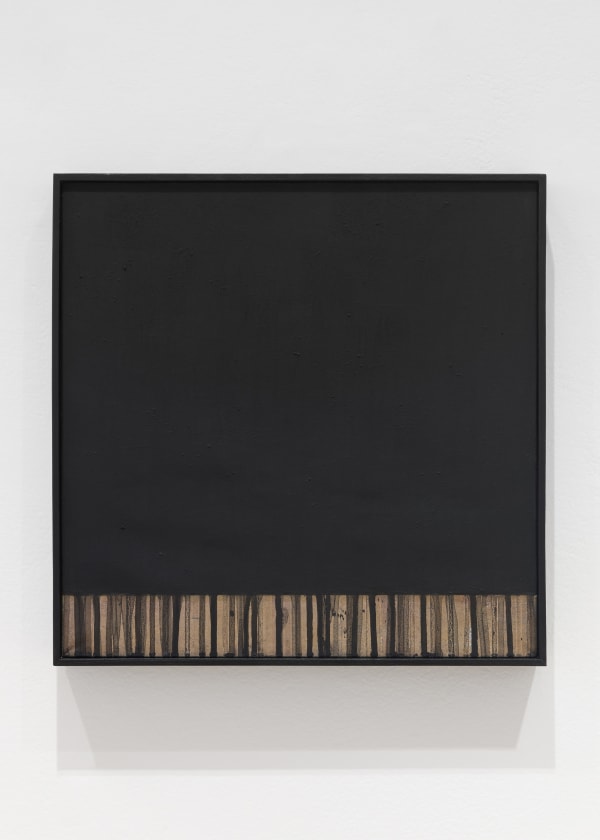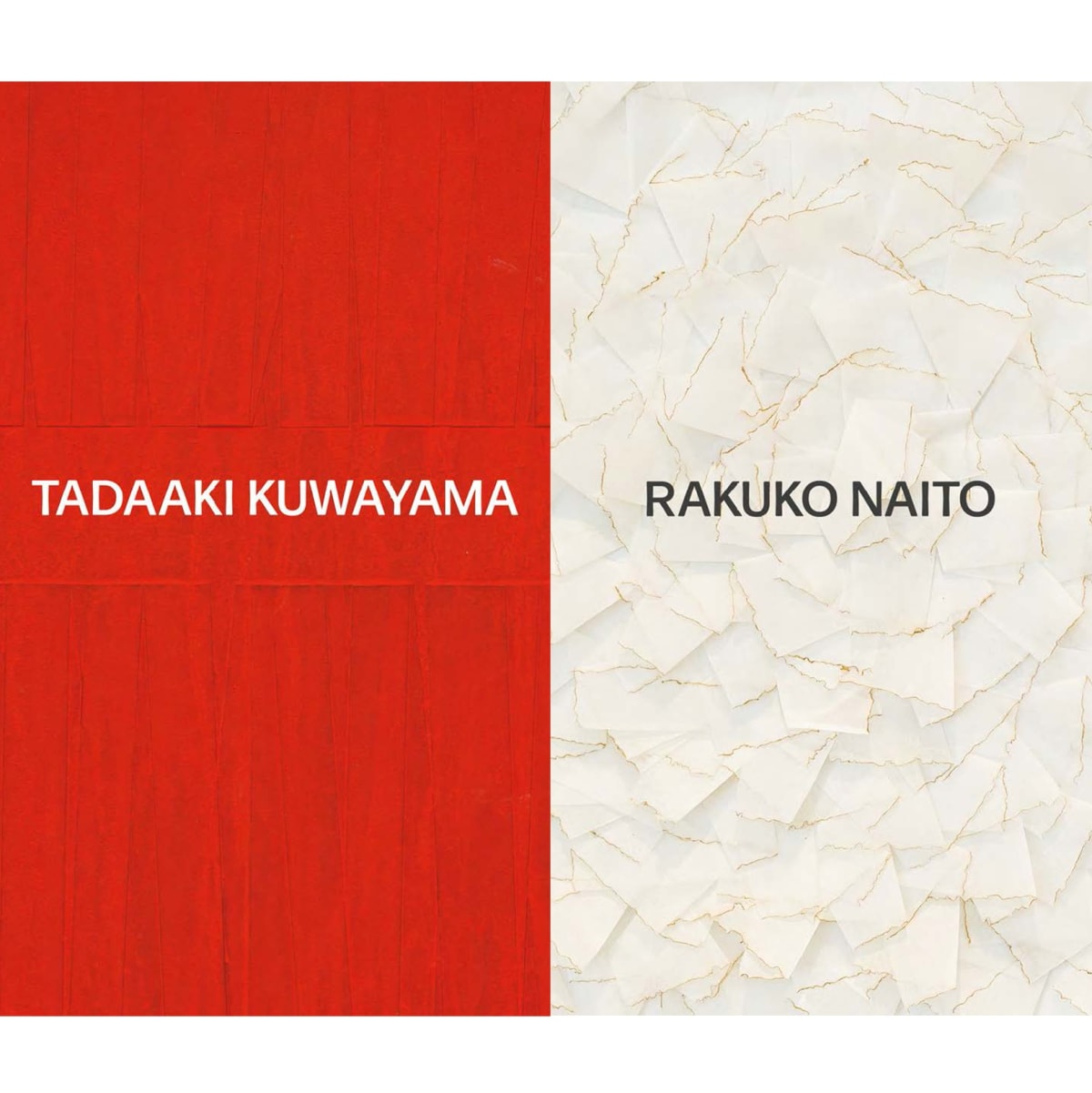Tadaaki Kuwayama Japanese-American, 1932-2023
Tadaaki Kuwayama (b. 1932 Nagoya, Japan) graduated from the Tokyo National University of Fine Arts and Music in 1956, having studied nihonga, a traditional form of Japanese painting. Together with his wife, artist Rakuko Naito, he came to the United States in 1958, at a similar time as Japanese artists Yayoi Kusama and Yoko Ono. After settling in New York, Kuwayama eschewed both traditional Japanese painting and Abstract Expressionism, which dominated contemporary art, and instead, associated with Minimalists such as Dan Flavin and Donald Judd. Kuwayama soon developed his own distinctive reductive style, typified by vivid fields of paint juxtaposed in horizontal and vertical compositions, as well as monochromatic canvases bisected by thin strips of chrome.
Through the 1960s, Kuwayama both refined his painting practice and began to explore three-dimensionality, creating painted wood-and-paper floor pieces and incorporating industrial materials to make work that was free from any trace of the artist’s hand.
Kuwayama has been the subject of numerous solo exhibitions at venues such as Institute of Contemporary Art, Tokyo, Akira Ikeda Gallery, Nagoya, Ingolstadt, Germany and National Museum of Art. His work has been presented in group shows at the Guggenheim Museum, (in the renowned Systemic Painting exhibition, 1966) and the San Francisco Museum of Modern Art and Pittsburgh’s Carnegie Institute.
Tadaaki Kuwayama lives and works in New York.
-
 Tadaaki KuwayamaTK532-68, 1968Acrylic on canvas81.3 x 81.3 cm
Tadaaki KuwayamaTK532-68, 1968Acrylic on canvas81.3 x 81.3 cm
32 x 32 inches -
 Tadaaki KuwayamaTK8932-1/2-’66, 1966Acrylic on canvas82.5 x 82.5 cm
Tadaaki KuwayamaTK8932-1/2-’66, 1966Acrylic on canvas82.5 x 82.5 cm
32 1/2 x 32 1/2 inches -
 Tadaaki KuwayamaTK4212 3/4-64, 1964Silver on paper on board32.4 x 32.4 cm
Tadaaki KuwayamaTK4212 3/4-64, 1964Silver on paper on board32.4 x 32.4 cm
12 3/4 x 12 3/4 inches -
 Tadaaki KuwayamaTK4612 3/4-64, 1964Gold leaf on board32.4 x 32.4 cm
Tadaaki KuwayamaTK4612 3/4-64, 1964Gold leaf on board32.4 x 32.4 cm
12 3/4 x 12 3/4 inches -
 Tadaaki KuwayamaTK4716-64, 1964Silver leaf on paper tape on board28.3 x 41 cm
Tadaaki KuwayamaTK4716-64, 1964Silver leaf on paper tape on board28.3 x 41 cm
11 1/8 x 16 1/8 inches -
 Tadaaki KuwayamaTK948-62, 1962White tape on board with acrylic paint121.9 x 77.5 cm
Tadaaki KuwayamaTK948-62, 1962White tape on board with acrylic paint121.9 x 77.5 cm
48 x 30 1/2 inches -
 Tadaaki KuwayamaTK11722 3/4-61, 1961White tape on board with acrylic paint35.6 x 57.8 cm
Tadaaki KuwayamaTK11722 3/4-61, 1961White tape on board with acrylic paint35.6 x 57.8 cm
14 x 22 3/4 inches -
 Tadaaki KuwayamaTK11933-61, 1961Black acrylic on paper on board83.8 x 61 cm
Tadaaki KuwayamaTK11933-61, 1961Black acrylic on paper on board83.8 x 61 cm
33 x 24 inches -
 Tadaaki KuwayamaTK6418-61, 1961Red dry pigment on paper in wooden box45.7 x 30.5 cm
Tadaaki KuwayamaTK6418-61, 1961Red dry pigment on paper in wooden box45.7 x 30.5 cm
18 x 12 inches -
 Tadaaki KuwayamaTK7448-61, 1961Black dry pigment on paper on board with aluminium strip121.9 x 92.7 cm
Tadaaki KuwayamaTK7448-61, 1961Black dry pigment on paper on board with aluminium strip121.9 x 92.7 cm
48 x 36 1/2 inches -
 Tadaaki KuwayamaTK7636-61, 1961Deep green pigment on paper on board91.4 x 61 cm
Tadaaki KuwayamaTK7636-61, 1961Deep green pigment on paper on board91.4 x 61 cm
36 x 24 inches -
 Tadaaki KuwayamaTK8147-61, 1961Black dry pigment with silver leaf on paper on canvas119.4 x 60.3 cm
Tadaaki KuwayamaTK8147-61, 1961Black dry pigment with silver leaf on paper on canvas119.4 x 60.3 cm
47 x 23 3/4 inches -
 Tadaaki KuwayamaTK8742 1/2-61, 1961Red pigment with silver leaf108 x 76.2 cm
Tadaaki KuwayamaTK8742 1/2-61, 1961Red pigment with silver leaf108 x 76.2 cm
42 1/2 x 30 inches -
 Tadaaki KuwayamaTK9536-61, 1961Black dry pigment on tape on board with bronze leaf91.4 x 62.2 cm
Tadaaki KuwayamaTK9536-61, 1961Black dry pigment on tape on board with bronze leaf91.4 x 62.2 cm
36 x 24 1/2 inches -
 Tadaaki KuwayamaTK1017 3/8-60, 1960Black dry pigment and silver leaf on paper and on canvas44 x 44 cm
Tadaaki KuwayamaTK1017 3/8-60, 1960Black dry pigment and silver leaf on paper and on canvas44 x 44 cm
17 3/8 x 17 3/8 inches
-

PAN Amsterdam
Tadaaki Kuwayama | Rakuko Naito | Tomas Rajlich 18 - 26 Nov 2023Stand 36 Tadaaki Kuwayama (b. 1932 Nagoya, Japan - d. 2023 New York, USA) and wife Rakuko Naito (b. 1935 Tokyo, Japan) both studied at the Nihonga (modern Japanese-style painting)...Read more -

Kuwayama / Naito
5 Apr - 2 Jun 2023Tadaaki Kuwayama (b. 1932 Nagoya, Japan) and wife Rakuko Naito (b. 1935 Tokyo, Japan) both studied at the Nihonga (modern Japanese-style painting) program of Tokyo National University of Fine Arts...Read more -

Repetitions
2 Mar - 6 May 2022On the 100th anniversary of Répétitions by Paul Eluard and Max Ernst, a publication of collages and poems by the Dada and Surrealist artists, The Mayor Gallery in the countdown...Read more -

Three Colours
12 Apr - 5 Jun 2021We are excited that The Mayor Gallery will be re-open to the public from the 12 April with our comprehensive exhibition Three Colours, Red-White-Blue . A wide range of artists...Read more -

Tadaaki Kuwayama
Radical Neutrality 7 Jun - 28 Jul 2017The work of Tadaaki Kuwayama (b. 1932 Nagoya, Japan) is characterised by “radical neutrality,” as art historian Michio Hayashi describes it. Since the early 1960s, Kuwayama has adamantly broken from...Read more
-

Tadakki Kuwayama
(1932 - 2023) October 2, 2023It is a great sadness to report the passing of Tadaaki Kuwayama. Tadaaki Kuwayama graduated from the Tokyo National University of Fine Arts and Music...Read more -

Tadaaki Kuwayama & Rakuko Naito
The Pavilions At Art Omi, Chatham, Ny June 1, 2023The Pavilions at Art Omi invite up to 18 artists and collectors to create their own Pavilions, or mini-museum buildings. The artists and collectors control...Read more -

TADAAKI KUWAYAMA
INTERVIEW BY STUDIO INTERNATIONAL June 29, 2017‘Here is only the art itself’ The Japanese-born artist recounts his refusal to dictate how spectators should view his work, his visual dialogue with Frank...Read more -

TADAAKI KUWAYAMA
NEW WORK, NEW YORK June 22, 2017New work by Kuwayama is to be shown inside of 50 West, a new 64-story residential tower in New York's financial district. CLICK HERE FOR...Read more


























